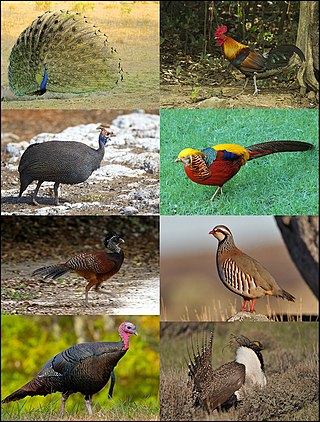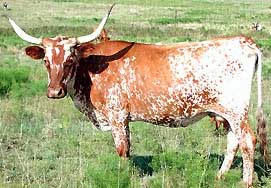
Galliformes is an order of heavy-bodied ground-feeding birds that includes turkeys, chickens, quail, and others. Gallinaceous birds, as they are called, are important in their ecosystems as seed dispersers and predators, and are often reared by humans for their meat and eggs, or hunted as game birds.

The Phasianidae are a family of heavy, ground-living birds, which includes pheasants, partridges, junglefowl, chickens, turkeys, Old World quail, and peafowl. The family includes many of the most popular gamebirds. The family includes 185 species divided into 54 genera. It was formerly broken up into two subfamilies, the Phasianinae and the Perdicinae. However, this treatment is now known to be paraphyletic and polyphyletic, respectively, and more recent evidence supports breaking it up into two subfamilies: Rollulinae and Phasianinae, with the latter containing multiple tribes within two clades. The New World quail (Odontophoridae) and guineafowl (Numididae) were formerly sometimes included in this family, but are now typically placed in families of their own; conversely, grouse and turkeys, formerly often treated as distinct families, are now known to be deeply nested within Phasianidae, so they are now included in the present family.

Ostriches are large flightless birds. Two living species are recognised, the common ostrich, native to large areas of sub-Saharan Africa, and the Somali ostrich, native to the Horn of Africa.

Anser is a waterfowl genus that includes the grey geese and the white geese. It belongs to the true goose and swan subfamily of Anserinae under the family of Anatidae. The genus has a Holarctic distribution, with at least one species breeding in any open, wet habitats in the subarctic and cool temperate regions of the Northern Hemisphere in summer. Some also breed farther south, reaching into warm temperate regions. They mostly migrate south in winter, typically to regions in the temperate zone between the January 0 °C (32 °F) and 5 °C (41 °F) isotherms.

Ictitherium is an extinct genus belonging to the family Hyaenidae and the subfamily Ictitheriinae erected by Trouessart in 1897. Ictitherium species were endemic to Eurasia and Africa during the Middle Miocene through the Early Pliocene and existed approximately 7.4 million years.

Hipparion is an extinct genus of three-toed, medium-sized equine belonging to the extinct tribe Hipparionini, which lived about 10-5 million years ago. While the genus formerly included most hipparionines, the genus is now more narrowly defined as hipparionines from Eurasia spanning the Late Miocene. Hipparion was a mixed-feeder who ate mostly grass, and lived in the savannah biome. Hipparion evolved from Cormohipparion, and went extinct due to environmental changes like cooling climates and decreasing atmospheric carbon dioxide levels.

Sinotherium is an extinct genus of single-horned elasmotheriine rhinocerotids that lived from the late Miocene to Early Pliocene. It was ancestral to Elasmotherium, demonstrating a very important evolutionary transition from nasal-horned elasmotheriines to frontal-horned elasmotheriines. Its fossils have been found in the Karabulak Formation of Kazakhstan, lower jaw and teeth have been found in Mongolia, and a partial skull is known from the upper part of the Liushu Formation of western China. Sinotherium diverged from the ancestral genus, Iranotherium, first found in Iran, during the early Pliocene. Some experts prefer to lump Sinotherium, and Iranotherium into Elasmotherium.

Chachalacas are galliform birds from the genus Ortalis. These birds are found in wooded habitats in the far southern United States (Texas), Mexico, and Central and South America. They are social, can be very noisy and often remain fairly common even near humans, as their relatively small size makes them less desirable to hunters than their larger relatives. As agricultural pests, they have a ravenous appetite for tomatoes, melons, beans, and radishes and can ravage a small garden in short order. They travel in packs of six to twelve. Their nests are made of sticks, twigs, leaves, or moss and are generally frail, flat structures only a few feet above the ground. During April, they lay from three to five buffy white eggs, the shell of which is very rough and hard. They somewhat resemble the guans, and the two have commonly been placed in a subfamily together, though the chachalacas are probably closer to the curassows.

Neohipparion (Greek: "new" (neos), "pony" (hipparion)) is an extinct genus of equid, from the Neogene (Miocene to Pliocene) of North America and Central America. Fossils of this horse have been found in Texas, Florida, Kansas, South Dakota, Montana, Nevada, Alabama, Oregon, and Mexico. This prehistoric species of equid grew up to lengths of 4.5 to 5 ft (1.4 to 1.5 m) long. In Florida, Neohipparion lived in a wooded grassland savanna environment during the dry season but moved to a wet environment when it came time to mate. The average age of death for a newborn colt was 3.5 years, with a juvenile mortality rate of 64% during its first 2 years of existence. Its diet consisted of grasses, C3 and C4 plants. δ13C values from ‘’N. eurystyle’’ fossils found in Florida indicate that it fed almost exclusively on C4 grasses.

Nannippus is an extinct genus of three-toed horse endemic to North America during the Miocene through Pleistocene, about 13.3—1.8 million years ago (Mya), living around 11.5 million years. This ancient species of three-toed horse grew up to 3.5 feet and weighed between 165 pounds to 199 pounds, which was around the same size as a domestic sheep.

Cormohipparion is an extinct genus of horse belonging to the tribe Hipparionini that lived in North America during the late Miocene to Pliocene. They grew up to 3 feet long.
Paleontology or palaeontology is the study of prehistoric life forms on Earth through the examination of plant and animal fossils. This includes the study of body fossils, tracks (ichnites), burrows, cast-off parts, fossilised feces (coprolites), palynomorphs and chemical residues. Because humans have encountered fossils for millennia, paleontology has a long history both before and after becoming formalized as a science. This article records significant discoveries and events related to paleontology that occurred or were published in the year 1984.
Paleontology or palaeontology is the study of prehistoric life forms on Earth through the examination of plant and animal fossils. This includes the study of body fossils, tracks (ichnites), burrows, cast-off parts, fossilised feces (coprolites), palynomorphs and chemical residues. Because humans have encountered fossils for millennia, paleontology has a long history both before and after becoming formalized as a science. This article records significant discoveries and events related to paleontology that occurred or were published in the year 1981.
Paleontology or palaeontology is the study of prehistoric life forms on Earth through the examination of plant and animal fossils. This includes the study of body fossils, tracks (ichnites), burrows, cast-off parts, fossilised feces (coprolites), palynomorphs and chemical residues. Because humans have encountered fossils for millennia, paleontology has a long history both before and after becoming formalized as a science. This article records significant discoveries and events related to paleontology that occurred or were published in the year 1982.
Paleontology, palaeontology or palæontology is the study of prehistoric life forms on Earth through the examination of plant and animal fossils. This includes the study of body fossils, tracks (ichnites), burrows, cast-off parts, fossilised faeces (coprolites), palynomorphs and chemical residues. Because mankind has encountered fossils for millennia, paleontology has a long history both before and after becoming formalized as a science. This article records significant discoveries and events related to paleontology that occurred in the year 1978.
Paleontology or palaeontology is the study of prehistoric life forms on Earth through the examination of plant and animal fossils. This includes the study of body fossils, tracks (ichnites), burrows, cast-off parts, fossilised feces (coprolites), palynomorphs and chemical residues. Because humans have encountered fossils for millennia, paleontology has a long history both before and after becoming formalized as a science. This article records significant discoveries and events related to paleontology that occurred or were published in the year 1972.

Pachystruthio is a genus of extinct bird which lived in Eurasia from the Late Pliocene to the Middle Pleistocene. Its fossils have been found in Hungary, Greece Crimea, Georgia, and China. The genus contains three species: P. pannonicus, P. dmanisensis, and P. transcaucasicus, which were all formerly placed with the ostrich genus, Struthio. An incomplete femur from the Nihewan Formation (China) has been assigned to Pachystruthio indet. P. dmanisensis has been estimated standing 4 meters tall and weighing up to 600 kg (990 lb), making it much larger than the modern ostrich and one of the largest known birds.

Bovina is a subtribe of the Bovini tribe that generally includes the two living genera, Bison and Bos. However, this dichotomy has been challenged recently by molecular work that suggests that Bison should be regarded as a subgenus of Bos. Wild bovinans can be found naturally in North America and Eurasia.
Leontoceryx is an extinct, little-known genus of pantherine felid. It was named in 1938 by Hungarian palaeontologist Miklós Kretzoi based on a partial upper jaw fossil with only three teeth present.
Anser thraciensis is an extinct species of water bird belonging to the living genus Anser. It was first named by Burchak-Abramovich and Nikolov (1984) from Trojanovo, Bulgaria. They also named Phalacrocorax serdicensis in the publication, from the same locality. The National Museum of Natural History, Sofia notes that 17 specimens of this taxon are presently held in their collections, catalogued as NMNHS 1407-1420, 1622-1625, and 1650-1652.
















